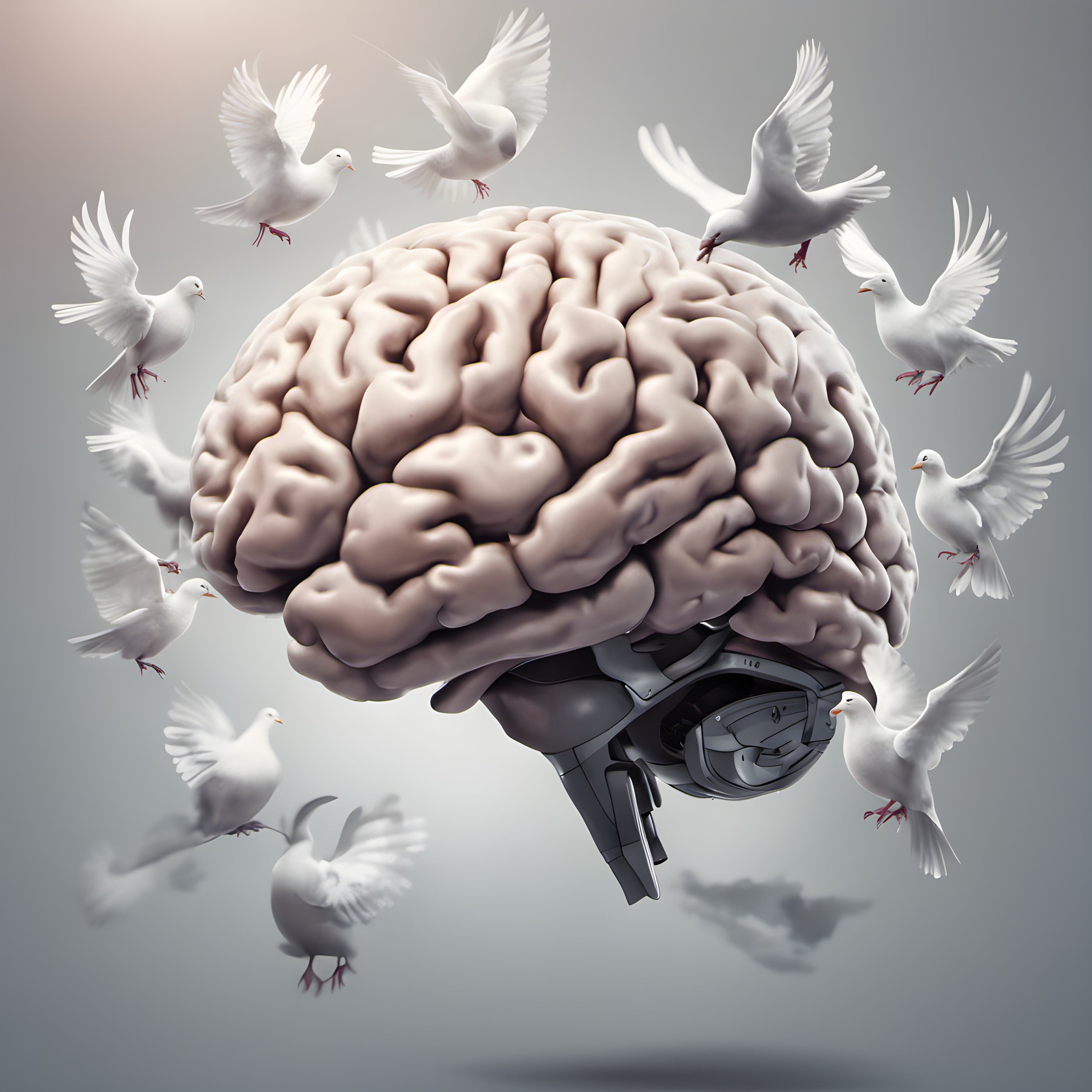The Neurological Superpower Called Hope
We’ve all faced what it feels like to have no hope in seemingly insurmountable situations. Everything feels overwhelming as waves of despair flow over you, threatening to take over your world.
But then, something shifts—a spark of hope appears. It’s small, but it’s enough to make you take that first step forward. Your heart lifts, you begin to breathe and you take another step, and another.
That’s the power of hope.
Hope isn’t just a fleeting emotion or wishful thinking. Neuroscience reveals it’s a dynamic, measurable force that profoundly influences the brain, body, and overall well-being. Conversely, the absence of hope—manifesting as hopelessness or despair—can derail both mental and physical health.
Let’s dive into the science behind hope, how it impacts your mind, and why cultivating it is a powerful act of resilience that shifts you toward prosperity.
The Cost of Hopelessness and Despair
While hope uplifts and motivates, hopelessness has the opposite effect, disrupting the brain and body in profound ways.
l. Amygdala Hyperactivity
Feelings of hopelessness activate the amygdala, the brain’s fear and stress center. When this happens, the hypothalamic-pituitary-adrenal (HPA) axis kicks into overdrive, flooding the body with stress hormones like cortisol. Cortisol plays a crucial role in the body’s acute stress response, preparing you to react to immediate threats by increasing heart rate, sharpening focus, and mobilizing energy reserves.
When cortisol remains elevated for extended periods, as it does during chronic hopelessness, it begins to wreak havoc on the body and mind. High cortisol levels interfere with the hippocampus, a brain region critical for learning and memory, leading to difficulty concentrating and retaining information. Prolonged exposure also impairs the prefrontal cortex, reducing your ability to make decisions and regulate emotions.
Physically, elevated cortisol contributes to increased blood pressure, disrupted sleep patterns, weakened immune function, and heightened inflammation, creating fertile ground for chronic illnesses like heart disease, diabetes, and autoimmune disorders.
This state is designed for survival, not for long-term thinking or emotional balance. Over time, chronic amygdala activation and excessive cortisol lead to heightened anxiety, irritability, and an inability to focus on solutions—trapping the mind in a cycle of stress and despair.
I’d always been a hopeful person. I could find the light inside the darkest places. Then the memories of my childhood burst into my consciousness, and my hope died in agony. I was physically so ill I couldn’t get out of bed for days, even as my mind spent all of its time replaying the horrors, and even creating more potential threats.
It took me a long time, and a lot of mind rewiring, to find my hope again. Yet I did. When I did, my energy and joy returned, stronger than ever.
Today I understand how to tap into my Hope Superpower when I need it. That knowledge changed my world, especially as we moved through Covid, wars, violence, rage and just plain chaos in our country.
ll. Suppressed Prefrontal Cortex Activity
Hopelessness dampens activity in the prefrontal cortex, the brain’s executive control center responsible for planning, decision-making, and regulating emotions. This suppression disrupts cognitive processes, making it difficult to assess situations rationally or find solutions to problems.
When the prefrontal cortex is inhibited, the brain shifts into a survival-driven mode dominated by the amygdala. This results in reactive, emotion-driven thinking, often characterized by impulsivity and an inability to evaluate long-term consequences. The individual feels mentally "stuck," unable to devise strategies for overcoming challenges.
This cognitive trap often leads to rumination, a cycle where negative thoughts are replayed endlessly. Over time, this loop reinforces feelings of helplessness, as the brain's focus narrows to immediate threats or obstacles, excluding potential solutions.
When my memories came up I was working with a coach who used a light hypnotic trance to “desensitize” what we thought was PTSD from caretaking people for ten years. That technique wired my mind into a cognitive trap. I completely succumbed to the fears and horrors of my little girl. Created even more extravagant and current threats and became a ball of goo in my bed replaying and replaying the most horrific potential events I could imagine. It was viscerally, emotionally, and mentally real to me. I curled up in a hopeless ball and created the worst nightmares I could imagine. Over and over again.
lll. Neurochemical Imbalances
Hopelessness is closely linked to imbalances in dopamine and serotonin, two neurotransmitters critical for mood regulation.
Dopamine Deficiency: Dopamine drives motivation, pleasure, and reward-seeking behavior. When dopamine levels are low, individuals often experience a lack of drive and a sense of emotional numbness. This can manifest as persistent apathy and a reluctance to engage in activities that once brought joy or satisfaction.
Serotonin Depletion: Serotonin helps regulate mood and promotes feelings of calm and stability. Low serotonin levels are often associated with heightened anxiety, irritability, and sadness. In hopelessness, this deficiency deepens emotional distress, making it harder to break free from negative thought patterns.
As I experienced these imbalances, the feelings of despair and worst case scenarios became a vicious cycle contributing to my supposed reality. I became more and more disengaged from myself, from my life and from any future that I might create. There was nothing but the past and potential new horrors, like a black tar sucking my life away.
The Neuroscience of Hope
Hope begins in the brain. Hope is more active than optimism, which is a general expectation of positive outcomes. It’s the belief that you can overcome challenges and create a better future, even in the face of uncertainty.
This belief triggers specific processes in the brain, lighting up areas tied to motivation, reward, and planning.
I. Activating the Brain’s Reward System
Hope engages the nucleus accumbens and ventral tegmental area (VTA), key players in the brain's reward system. These regions release dopamine, the neurotransmitter responsible for motivation, pleasure, and reward prediction.
Dopamine plays a central role in creating a sense of possibility and driving action. When we envision a positive future or imagine overcoming a challenge, the brain rewards us with a surge of dopamine. This not only makes us feel good but also motivates us to pursue our goals. The process creates a feedback loop: hopeful thoughts trigger dopamine, and dopamine reinforces hopeful actions, strengthening the neural pathways that sustain hope over time.
Additionally, dopamine’s effects extend beyond immediate rewards. It enhances learning and memory by improving the brain's ability to focus and retain information related to achieving desired outcomes. This is why hope often feels energizing—it primes the brain for goal-directed behavior, ensuring that small successes along the way amplify feelings of optimism and progress.
As I began exploring alternative answers to what had become an unlivable life, I found mind methods specifically designed to rewire my mind and its repetitive thinking. One of the first things I did was to apply a method that allowed me to create a joyful future moment that I could fully embrace. As I rewired my mind toward this future, my dopamine activated again. I began to thread positive thoughts together into increasingly longer and more positive situations in my life.
Life began again. And Hope began to grow.
II. Engaging the Prefrontal Cortex
The prefrontal cortex, often referred to as the brain’s executive center, is critical for planning, problem-solving, and decision-making. It’s also the region that translates hope into action by formulating strategies to achieve future goals.
When we feel hopeful, the prefrontal cortex becomes more active, enabling us to weigh options, evaluate risks, and devise pathways toward success. This heightened activity shifts the brain from a reactive state, dominated by survival instincts, to a proactive state focused on growth and possibility.
Hope also enhances emotional regulation, another function of the prefrontal cortex. By balancing emotional responses, the prefrontal cortex helps keep fear and anxiety in check, creating mental space to focus on solutions rather than obstacles. This sense of agency—feeling in control of your path—plays a crucial role in sustaining motivation, even in the face of setbacks.
I began to balance my emotions, the positive thoughts overtook the negative ones and gradually became the main balance of my emotional state. My thinking became logical and fact-based again, eliminating the horror stories I’d told myself over and over again. New ideas started to flow, and I was able to work again, to strategize for my clients and in my own world.
III. Enhancing Neuroplasticity
Neuroplasticity refers to the brain's ability to form new connections and adapt to experiences—a process that is essential for learning, growth, and resilience. Hope plays a vital role in promoting neuroplasticity by fostering a mindset of possibility and change.
When we focus on hopeful thoughts, the brain strengthens neural circuits associated with optimism, creativity, and problem-solving. These pathways make it easier to recover from adversity, as the brain becomes more adept at finding alternative routes to success.
Hope also counteracts the negative effects of chronic stress, which can erode neuroplasticity over time. Stress hormones like cortisol can shrink the hippocampus, a brain region critical for memory and learning, while hope can reverse these effects by encouraging the formation of new, healthy neural connections.
In practical terms, this adaptability allows individuals to bounce back from setbacks with greater ease.
The mind work I apply with myself and my clients is designed to rewire our brains, using neuroplasticity. As I began my journey back from despair to hope, my methods literally rewired my mind and its mindware. The more time I spent using my methods, the more hopeful I became. The more hopeful I became, the more my mind learned that hope was my desired state. And it shifted to support that training from my mind work.
How Hope Affects the Body
Hope’s benefits extend beyond the mind, directly influencing physical health by fostering a balanced physiological state:
l. Reduced Stress Hormones
Chronic hopelessness floods the body with cortisol, the stress hormone that prepares us for short-term survival. While useful in acute situations, prolonged cortisol exposure weakens the immune system, disrupts sleep, and increases the risk of conditions like high blood pressure, obesity, and heart disease.
Hope interrupts this cycle by reducing cortisol levels, calming the body’s stress response. Studies show that people who consistently practice hopeful thinking experience improved stress resilience, better sleep quality, and fewer stress-related physical symptoms.
Even after I found my hope I was faced with cortisol floods. My mind had trained my body to stay in an excited and ready state all the time. My immune system was non-existent, I barely slept and my body was physically a mess. I‘m an extreme case due to the depth and duration of childhood trauma which impacted my physical health significantly. Today, I continue to work with my Autonomic Nervous System (ANS ) to make sure that it’s relaxed and calm, knowing my life is safe and exactly as I want.
ll. Improved Cardiovascular Health
High stress places significant strain on the cardiovascular system, increasing the risk of heart attacks and strokes. Hope mitigates these risks by promoting relaxation and lowering stress-induced inflammation in blood vessels.
Individuals with higher levels of hope tend to engage in healthier behaviors, such as regular exercise, better diet choices, and routine medical checkups. These steps further reduce cardiovascular strain, creating a virtuous cycle of physical and emotional well-being.
I was lucky. My heart didn’t have any impact from my downtime. Yet I know clients who faced major blood pressure and heart rate issues following tough life times. It can be extremely serious, since despair is one of the largest triggers of stress, and hopelessness magnifies that stress.
lll. Enhanced Immune Function
Hope has a measurable impact on the immune system. Chronic stress suppresses immune function, leaving the body more susceptible to infections and illnesses. Hope, by contrast, reduces inflammation markers and boosts the production of immune cells, such as natural killer (NK) cells that fight infections.
For instance, cancer patients who maintain a hopeful outlook during treatment demonstrate stronger immune responses, leading to better recovery outcomes. This highlights how hope’s influence on the brain translates into tangible physical resilience.
I was diagnosed with a non-functioning immune system, which allowed neural Lyme disease, black mold and more to colonize my body. The tests showed almost no immune system function which is not a good thing. As I healed and rewired my mind, as well as supplementing my immune system, my body grew more healthy. My last test showed my immune system functioning at a very high level… thanks to my mind’s rewiring. What a gift:)
Cultivating Hope
The good news is that hope isn’t a fixed trait—it’s a skill that can be learned over time.
It comes down to paying attention to your attention and consciously shifting when you feel yourself dipping into hopelessness and thinking hopeless thoughts.
Here are practical strategies to foster hope:
l. Set Your Boundaries
One thing I learned is that when we are hopeless, we often allow ourselves to be put into uncomfortable, stressful positions by others. We don’t seek to protect ourselves because we’re either too negative, exhausted, or, we’re seeking some form of “hope” from serving others.
In my case, I gave up any boundaries I had. Just so someone would come and save me from my past. I know, it sounds strange, but it’s how our minds work when we are in deep negativity like hopelessness. I literally almost killed myself working for people who didn’t care if they hurt me, took advantage of me. Just to get them to like me so I could be safe.
I have learned to draw my boundaries early now. I’m still learning how to do it in the best manner, that’s a work in progress. But I do now understand and feel the hope that’s created for myself when I simply draw the line and say enough. Every single time I choose myself, my hope expands. Why wouldn’t it? I am the source and focus of my hope. Prioritizing myself is fuel for my future.
ll. Practice Visualization
Imagine positive outcomes in vivid detail.
Visualization activates the same brain areas involved in actually achieving those outcomes, helping to create a sense of possibility and motivation. Visualization using sensory systems creates a direct path to the unconscious mind. The act of visualization triggers unconscious neuroplasticity and we literally begin to rewire our mindware toward the focus of our sensory visualization. The more attention we pay, the stronger the wiring becomes.
I have a number of mind methods that use a very specific form of visualization that serves to re-write the unconscious mind and its mindware, away from despair and toward full blown hope. My free and open ebook, 7 Mindshifts to Take Back Your Life shares the simpler approaches that you can use at home safely and effectively,
ll. Reframe Negative Thoughts
I know, everybody says to focus on the positive. We just don’t do it. Maybe we don’t believe it has an impact. IT DOES.
Our attention, aka our thoughts, is what our mind uses to determine what it thinks we want. When we focus on negative things, we wire in the direction that we want to experience that negative thing, or things similar.
When we focus on what we do want, and create that focus with the right sensory information, we rewire that negative programming. The more we focus, the more we program toward that focus.
Here’s my trick. Whenever I catch myself in a negative thought or feeling hopeless, I stop. I laugh. I tell my mind that I understand why it might think that what I’m focusing on is what I want and then I tell it that what I really want is…. And I focus with all my senses on a moment that is the exact situation I actually want. Do it repetitively and it changes darned near everything.
One other thing to note. Change doesn’t have to be big, shifts don’t have to be significant. Small, tiny shifts in how you think and focus are enough. When you’re totally in despair and helplessness do not expect yourself to bounce right into full blown hope. Think of it as climbing a ladder. Reach for a better feeling moment, create a step forward that is the direction you want and revel in it. Then create another, and another. Don’t expect yourself to shift in an instant - that’s not fair to you or your mind.
lV. Ditch the Naysayers
One of the most important and toughest lessons I’ve learned is to ditch the people in your life that contribute who share their negative outlooks, aka, the downers. Yes, you want to be there for people who are having issues or concerns. Yet you don’t need to share their angst to the point of creating your own.
I was raised to pretty much believe I had to take care of the planet. I spent too many years sacrificing my own joy and well being in the hope of making someone else happy. Yep, there’s that hope word. I know now that I pointed it in the wrong direction.
Find the people who give you hope, who are positive, joyful and focused on creating their dreams. Leave the nightmare naysayers behind.
V. Notice Progress
We all run so fast and do so much. We’re trained to focus on the list that’s in front of us, not acknowledge our achievements. Which means we truly are like gerbils on a wheel sometimes, running as fast as we can in hope of getting to the next and next and next goal.
That’s why noticing and acknowledging progress is important. That bit of focused attention reinforces the mind’s reward system, creating a positive feedback loop that sustains hope.
Here’s a trick. Get a box. Each time you complete something during the day, drop a piece of paper with a quick note of what you accomplished. At the end of each day, look in the box and give your attention to all that you achieved. Some days it may be one thing that was touched, others it may be a pile of small things. It doesn’t matter. The point is to consciously pay attention to and acknowledge accomplishment of any form. When you pay attention to something you’ve completed, your mind notes that reward and reinforces positive emotions like, you guessed it, hope.
The Bottom Line
Hope is far more than a feeling—it’s a neurological superpower that can reshape our lives. By activating the brain’s reward and planning systems, hope creates pathways to resilience, motivation, and growth.
The choice between hope and despair is not just emotional—it’s a neurological tug-of-war.
Hope strengthens the prefrontal cortex and reward systems, fostering creativity and resilience.
Hopelessness, on the other hand, hijacks the amygdala and suppresses executive functioning, trapping the mind in a cycle of stress and fear.
By understanding these dynamics, we can each make conscious choices to cultivate hope, transforming not only how we think but also how we live.
Photo courtesy of calenzani





